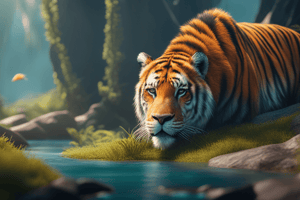Podcast
Questions and Answers
What distinguishes mammals from other animals?
What distinguishes mammals from other animals?
- Regulating body temperature internally
- Being cold-blooded
- Having scaly skin
- Producing milk to nourish their young (correct)
Which group of animals relies on external sources like the sun to help maintain body heat?
Which group of animals relies on external sources like the sun to help maintain body heat?
- Mammals
- Birds
- Amphibians
- Reptiles (correct)
From the following animals, which one is NOT a mammal?
From the following animals, which one is NOT a mammal?
- Shrew
- Komodo dragon
- Gecko (correct)
- Blue whale
What characteristic distinguishes reptiles from mammals?
What characteristic distinguishes reptiles from mammals?
Which group of animals evolved from reptiles?
Which group of animals evolved from reptiles?
In terms of body temperature regulation, which group of animals can internally regulate their body heat?
In terms of body temperature regulation, which group of animals can internally regulate their body heat?
Which group of animals is distinguished by their feathers and ability to fly?
Which group of animals is distinguished by their feathers and ability to fly?
Which group of animals is cold-blooded and has an exoskeleton?
Which group of animals is cold-blooded and has an exoskeleton?
What adaptation allows amphibians to absorb water and oxygen through their skin?
What adaptation allows amphibians to absorb water and oxygen through their skin?
Which group of animals has an estimated 1 million species, making them the most diverse on Earth?
Which group of animals has an estimated 1 million species, making them the most diverse on Earth?
Which group of animals has evolved from small, feathered dinosaurs?
Which group of animals has evolved from small, feathered dinosaurs?
Which group of animals exhibits an incredible range of habitats from the arctic tundra to the tropical rainforest?
Which group of animals exhibits an incredible range of habitats from the arctic tundra to the tropical rainforest?
Study Notes
Exploring the Diverse World of Animals: Mammals, Reptiles, Birds, Amphibians, and Insects
Animals are a vast and captivating part of our natural world, encompassing an incredible array of life forms. As we delve into the realm of these fascinating creatures, it's beneficial to understand the key groups that make up our planet's biodiversity. In this article, we'll explore the mammals, reptiles, birds, amphibians, and insects, each offering unique adaptations and habitats that have shaped our planet's ecology.
Mammals
Mammals are warm-blooded creatures, distinguished by their ability to produce milk to nourish their young. The mammal family tree is vast, encompassing everything from the microscopic shrew to the colossal blue whale. Mammals evolved from reptiles and have been a defining force in the ecology of our planet for over 160 million years. Mammals have a diverse range of habitats, from the deserts of the Southwestern United States to the rainforests of Brazil.
Reptiles
Reptiles are cold-blooded animals, known for their scaly skin. Unlike mammals, reptiles cannot regulate their body temperatures internally; they rely on external sources like the sun to help them maintain their body heat. Reptiles have been around for millions of years, with the earliest reptiles appearing approximately 315 million years ago. Reptiles come in all shapes and sizes, from the tiny gecko to the imposing Komodo dragon.
Birds
Birds are warm-blooded creatures distinguished by their feathers and ability to fly. Birds have been around for approximately 150 million years, evolving from small, feathered dinosaurs. Birds exhibit an incredible range of habitats, from the arctic tundra to the tropical rainforest. Their feathers provide them with insulation, camouflage, and the ability to fly.
Amphibians
Amphibians are cold-blooded creatures, distinguished by their moist skin and aquatic or semi-aquatic life stages. Amphibians have been around for approximately 300 million years, with the earliest amphibians appearing around the same time as the earliest reptiles. Amphibians come in all shapes and sizes, from the tiny frog to the massive African bullfrog. The moisture in their skin allows them to absorb water and oxygen, an advantageous adaptation that helps them thrive in various ecosystems.
Insects
Insects are cold-blooded creatures, distinguished by their exoskeletons and six legs. Insects have been around for approximately 450 million years, with the earliest insects appearing around the same time as the earliest fish. Insects come in all shapes and sizes, from the tiny ant to the enormous African elephant beetle. Insects are the most diverse group of animals on Earth, with an estimated 1 million species, many of which remain undiscovered.
Conclusion
Mammals, reptiles, birds, amphibians, and insects all play vital roles in our planet's ecosystems. Each group has unique characteristics that allow them to thrive in various habitats. By understanding their ecological importance, we can better appreciate the natural world and work towards preserving its biodiversity.
Studying That Suits You
Use AI to generate personalized quizzes and flashcards to suit your learning preferences.
Description
Delve into the fascinating world of animals by exploring mammals, reptiles, birds, amphibians, and insects. Learn about the unique characteristics and habitats of each group of creatures, as well as their ecological importance in our planet's biodiversity.




